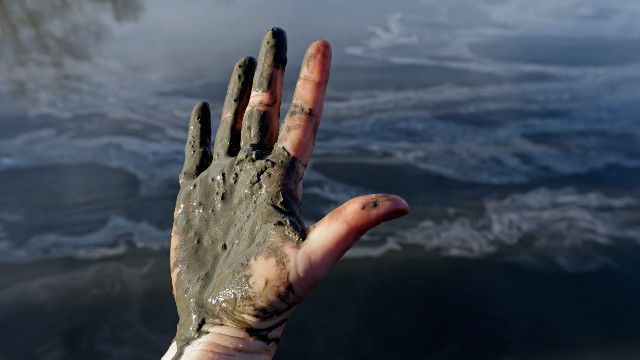This post originally appeared at Truthout.

As crude a weapon as the cave man’s club, the chemical barrage has been hurled against the fabric of life – a fabric on the one hand delicate and destructible, on the other miraculously tough and resilient, and capable of striking back in unexpected ways. These extraordinary capacities of life have been ignored by the practitioners of chemical control who have brought to their task no “high-minded orientation,” no humility before the vast forces with which they tamper.
— Rachel Carson, Silent Spring
It has been snowing all day here, the biggest storm of the season to date. There is at least a foot piled atop the stacked cordwood outside my office window, the trees are frosted and everything is white and silent save for the hiss of flakes coming to rest. I am not one of those people who detests winter; in fact, I adore it, because it is beautiful. What I see out my window in the fading light of this late afternoon reminds me, again, how truly gorgeous this country is.
And then I remember that it is being wrecked, poisoned, denuded and ruined for money and I want to go outside and sit in the snow and listen to it as it buries me until I am gone from this country that would do such harm to itself, brazenly and without restraint, for profit.
On Tuesday afternoon, Duke Energy in North Carolina released a press statement announcing that somewhere between 50,000 and 82,000 tons of coal ash, which created some 27 million gallons of water polluted with heavy metals and other poisons, had been accidentally dumped into the Dan River, near the towns of Danville and Eden. Eden, because God, or Fate and definitely the coal industry have a vicious sense of humor. Duke Energy waited 24 hours to report the spill. They may not have said anything at all, but a security guard noticed an unusually low water level in what is called an “ash pond,” which is where this crud is stored. That low water level means most of the poison had escaped into the river by the time it was discovered.
The Dan River is a source of drinking water for the region, as the Elk River was in West Virginia when the coal industry dumped poison there a few weeks ago. According to EcoWatch, “The spill is the equivalent of 413 to 677 rail cars of wet coal ash poured into a public drinking water source. If a freight train full of this toxic waste had derailed, there would have been immediate notification and quick news coverage in order to inform and protect the public.” It appears at this point to be the third largest coal ash spill in American history.
This is what coal ash looks like. By Tuesday afternoon, the Dan River had turned completely grey.
The worst drought in living memory is currently afflicting the State of California and other parts of the West, severe water restrictions have been put in place, and every available weather model predicts the situation will “persist or intensify” through April and beyond. California Republicans have chosen to use the parched landscape as a way to attack Democrats, claiming that policies including environmental protection are to blame for the drought… because humans can’t cause climate change, but Democrats can cause droughts, or something.
As it turns out, however, there may be another explanation for why California and much of the West is drying up:
America’s oil and gas rush is depleting water supplies in the driest and most drought-prone areas of the country, from Texas to California, new research has found. Of the nearly 40,000 oil and gas wells drilled since 2011, three-quarters were located in areas where water is scarce, and 55% were in areas experiencing drought, the report by the Ceres investor network found. Fracking those wells used 97 billion gallons of water, raising new concerns about unforeseen costs of America’s energy rush.
It can take millions of gallons of fresh water to frack a single well, and much of the drilling is tightly concentrated in areas where water is in chronically short supply, or where there have been multi-year droughts. In California, where a drought emergency was declared last month, 96% of new oil and gas wells were located in areas where there was already fierce competition for water. The pattern holds for other regions caught up in the oil and gas rush. Most of the wells in New Mexico, Utah and Wyoming were also located in areas of high water stress, the report said.
It’s not just the West that is being affected by the practice of fracking. A report by the Environment America Research & Policy Center titled “Shalefield Stories” has collected the personal testimonies of dozens of people from all across the country who are suffering from the aftereffects of natural gas extraction, processing and waste disposal.
“Across the country,” reads the report, “fracking is contaminating drinking water, making nearby families sick with air pollution, and turning forest acres into industrial zones. We believe it is vital for the public to hear directly from people living on the frontlines of fracking, and so Environment America Research & Policy Center is supporting the Shalefield Stories project-a booklet designed and published by local activists where people impacted by fracking tell their stories, in their own words.”
Read it. It is the diary of a dying country.
The Keystone XL Pipeline is under construction, but not yet complete, and is still awaiting approval from the Obama administration. A few days ago, the State Department released a report on Keystone XL claiming that there are no serious environmental concerns regarding the pipeline, despite the fact that it will be carrying tar sands oil — the dirtiest fossil fuel on the planet — through America’s breadbasket and very close to the most important water aquifer in the nation.
Beyond the very basic, thousand-times proven fact that the Keystone XL pipeline will leak, because all pipelines leak when they are not exploding in huge fireballs that lay waste to the countryside and light up the sky for miles, is the fact that the extraction process for tar sands oil — before it ever sees the inside of any pipeline — is actually more pollutive by two to three orders of magnitude than previously understood.
The president of the United States did not deign to give a single damn about these or any other inconvenient facts about Keystone and tar sands oil when he stood up before the American people during his State of the Union address last week and talked about “energy independence” in terms so rosy that they would make an oil baron blush.
He didn’t talk to you about any of this… but maybe you might want to talk to him. The 30-day period for public comment on the Keystone XL pipeline project has officially begun, and if you have a mind to, you can speak your mind on the matter here. Click the blue “Comment Now” button in the upper right corner and speak your piece.
I would not in any way presume to tell you what to say or how to say it, and I offer no guarantees that commenting on that site will be anything other than a waste of time; the damned pipeline is half-built already, the State Department has blithely brushed off a mountain of extremely unsettling environmental concerns, so I am pretty much convinced that the president is going to approve this thing even if God appears before him in the Oval Office and denounces the project with brimstone and fire. The president doesn’t work for God, and he sure as hell doesn’t work for us. He works for the energy industry that is turning this indescribably beautiful country — this indescribably beautiful world — into a parched, poisoned wasteland.
Speak your mind anyway, if you feel like it. Unlike the energy policies that are filling the rivers and the air with poison, drying up the water out West while making the tap water back East flammable, speaking your mind does no harm. Who knows? They may even listen. Stranger things have happened, and you still have time, because the seas have not risen to reclaim us.
Yet.


